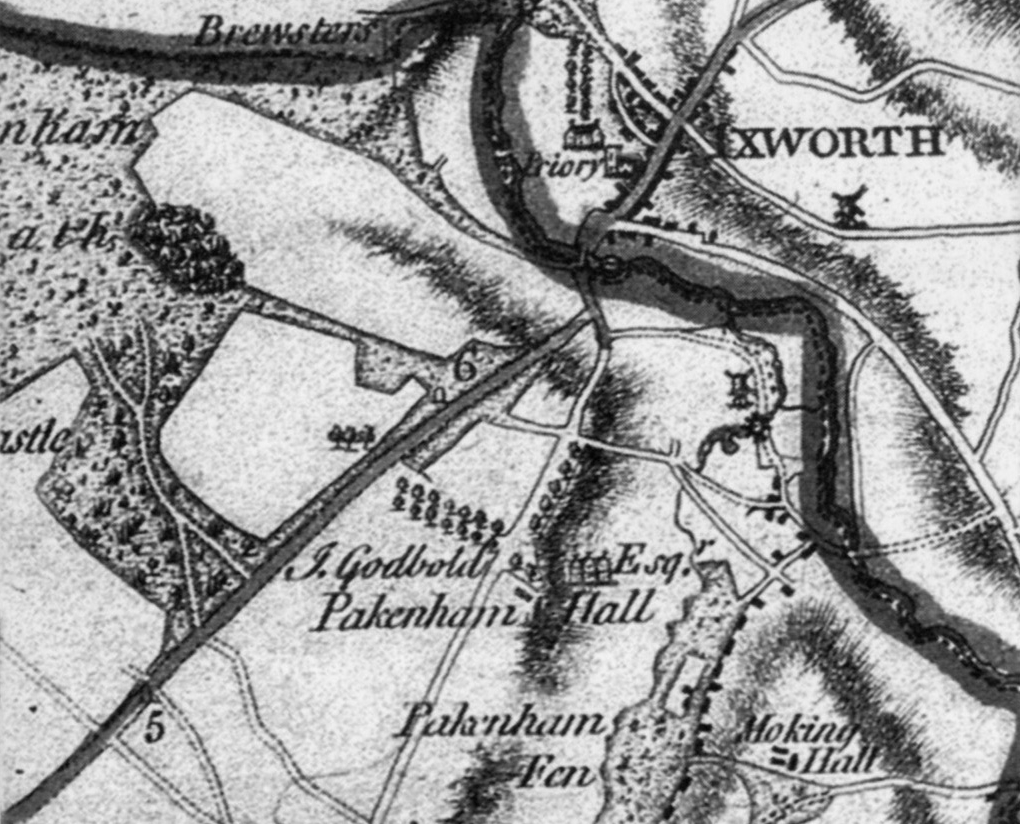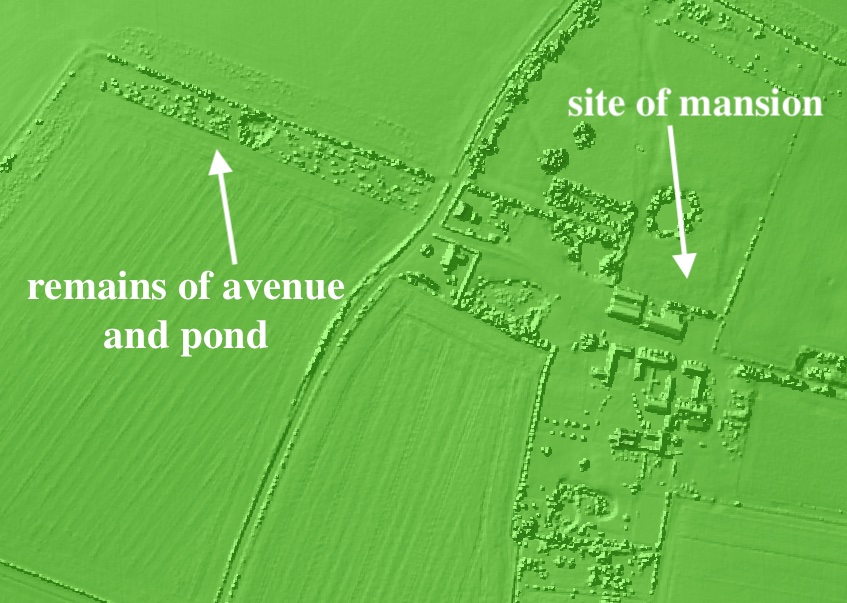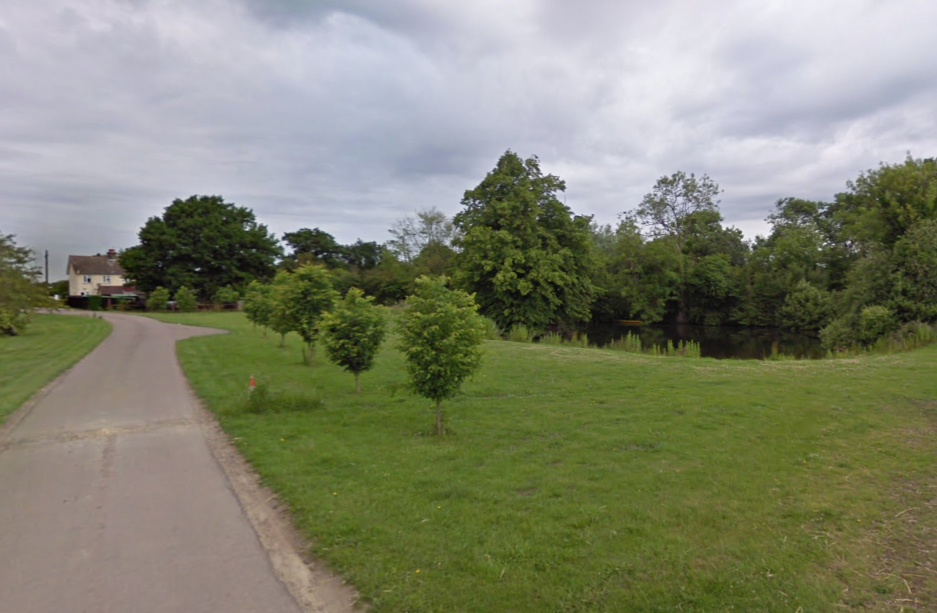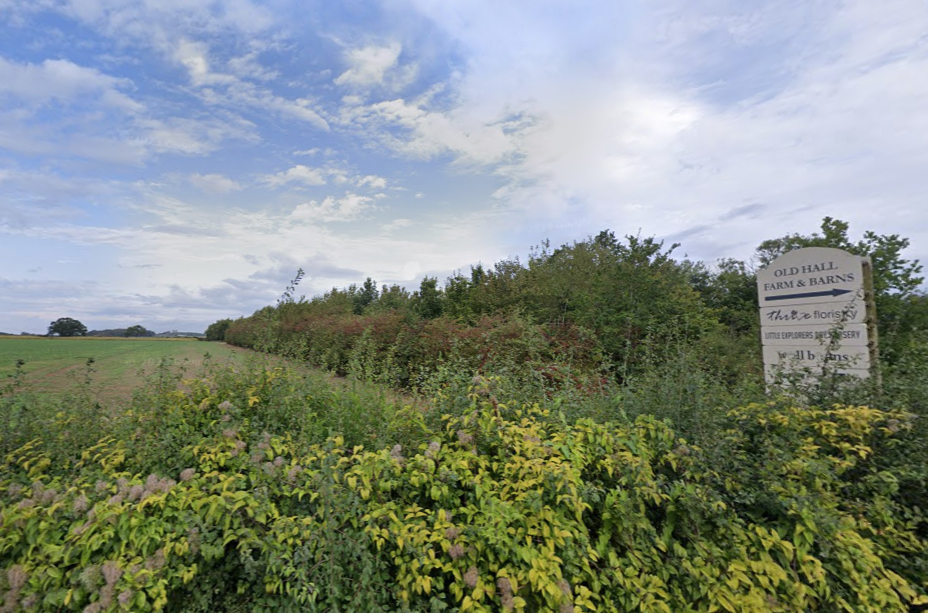(site of Pakenham Hall demolished between 1804 and 1810)
Parish: PAKENHAM
District Council: WEST SUFFOLK (previously St Edmundsbury)
TL 929688
Not open to the public


The site of Pakenham Old Hall stands in open countryside c. 1.6km (1ml) north of the village of Pakenham c. 10km (6mls) north-east of Bury St Edmunds and south of Ixworth. The parish is famous for having both a surviving windmill and water mill that are slightly north of the site. The land slopes gently down to the east to a tributary of the Black Bourne river as it flows northward from the village to form fen and low-lying land. Entrance to the site is from the west, off the course of an old Roman road linking Ixworth and Long Melford to the south.
Once owned by the Abbey of St Edmund, after the Dissolution in 1545 Pakenham was granted to Robert Spring and his son Thomas, a merchant from Lavenham. The Spring family resided at Pakenham Hall from the sixteenth to eighteenth century, living in a large mansion with twenty-three hearths in 1672 when it was the main seat of Sir William Spring Bt. Most of the 485ha (1,200a) estate passed through marriage to Thomas Discipline Esq in 1735 and on his death descended to his two daughters.
The manor house of Pakenham Hall is depicted on Hodskinson’s map of 1783 with a triple-gabled frontage, when it was the seat of J. Godbold Esq., who had married one of Sir William’s daughters. The map shows an avenue of trees to the west of the mansion that ran beyond the old Roman road to the main road further north-west from Ixworth to Bury St Edmunds, now the A143. In 1786 the Pakenham Hall Estate was sold to Sir Henry Gough Bt, later Baron Calthorpe.
The mansion was shown on the enclosure map of 1804, but had gone by the time of estate maps of 1810. The site, including a number of surviving ponds, became a tenanted farmhouse named ‘Old Hall Farm’ during the nineteenth century, whilst ownership passed through the Gough Calthorpe family to Augustus Cholmondeley Gough Calthorpe who died in 1910. The present house, south of the original mansion site and renamed ‘Pakenham Old Hall’ is believed to have been built around this time.
LiDAR images show earthworks of the old mansion site with further earthworks centred on the house running north-west to the old Roman road. Today, there is a large pond very close to the mansion site and on the same axis. The lines of the earthworks continue into the field beyond the old Roman road, which today are represented by a thicket of trees and shrubs with an overgrown pond at its centre. The width of the thicket suggests this to be the ghost of the eighteenth-century avenue depicted on Hodskinson’s map, with the possibility of ornamental ponds between the lines of trees, which probably originated with the building of the original Tudor mansion to create an air of grandeur on arrival.


SOURCES:
Copinger, W. A., The Manors of Suffolk, Vol. 6, 1910.
Jones, Revd C. W., ‘Pakenham’ in Suffolk Institute of Archaeology and History, Vol. X Part 2, 1899.
Kelly’s Directory of Cambridge, Norfolk and Suffolk, 1922.
Page, Augustine, A topographical and genealogical history of the County of Suffolk, 1847.
Pakenham Parish Plan, 2010.
Suffolk Institute of Archaeology and History, Proceedings Vol. XXXVI Part 2, 1985, Excursions 1985.
White, William, History, Gazetteer, and Directory of Suffolk, 1855.
Whitwell, Nigel, R., Pakenham – Village of Two Mills, 1985.
https://www.pakenham-village.co.uk/History/PV2Mbk/PV2Mbk-s10-C7-ManorsOfPakenham.htm Chapter 7 – The Manors of Pakenham (accessed April 2021)
Census: 1841, 1851, 1861, 1871, 1881, 1891, 1901, 1911.
Maps:
1783 Hodskinson’s Map of Suffolk in 1783.
1841 (surveyed 1840) tithe map and apportionments.
1883 (surveyed 1882 to 1883) OS map.
1905 (revised 1903) OS map.
Heritage Assets:
Suffolk Historic Environment Record (SHER): PKM 044.
Suffolk Record Office (now Suffolk Archives):
SRO (Ipswich) HD11/475/Pakenham/2266. Pakenham Estate of Lord Calthorpe, 1809.
Suffolk Archives HA530/2/8/2. Wilson Family Estates, Evidence of Title and associated papers, Pakenham, 1864–72.
Suffolk Archives HD526/107/5/2. Photographs of supposed site of old hall and Pakenham Old Hall Farm, 1900-1930.
The National Archives, Kew PROB 11/376/270. The Will of Sir William Spring of Pakenham Hall, Suffolk, 7 June 1684
Site ownership: Private
Study written: June 2025
Type of Study: Desktop
Written by: Tina Ranft
Amended:
